Understanding Language Acquisition in Developmental Disorders Essay
VerifiedAdded on 2021/04/17
|8
|2075
|104
Essay
AI Summary
This essay delves into the crucial significance of studying language acquisition in the context of developmental disorders. It emphasizes how examining language acquisition in individuals with conditions like autism, attention deficit hyperactivity disorder (ADHD), and dyslexia provides valuable insights into the complexities of language development and the specific speech impairments associated with each disorder. The essay analyzes the speech impairments of reception, fluency, and voice disorders in relation to these conditions. The study of these disorders offers a deeper understanding of the challenges faced by children with speech difficulties and helps in developing effective strategies to assist them. The essay also highlights the complex biological aspects of language, including the neural networks involved in speech production and recognition. Overall, the essay underscores the importance of understanding these disorders to improve language assistance strategies for children facing these challenges.
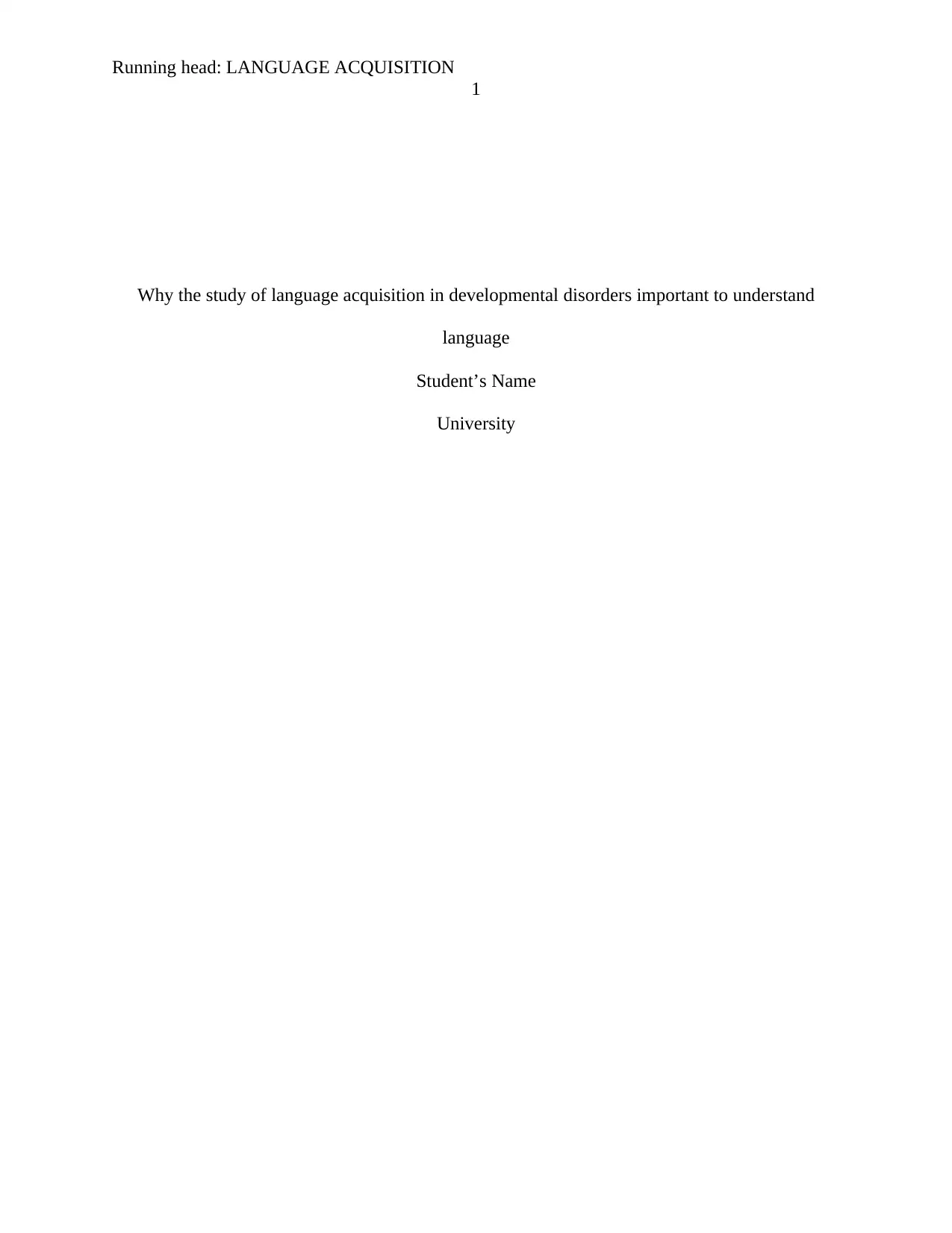
Running head: LANGUAGE ACQUISITION
1
Why the study of language acquisition in developmental disorders important to understand
language
Student’s Name
University
1
Why the study of language acquisition in developmental disorders important to understand
language
Student’s Name
University
Paraphrase This Document
Need a fresh take? Get an instant paraphrase of this document with our AI Paraphraser
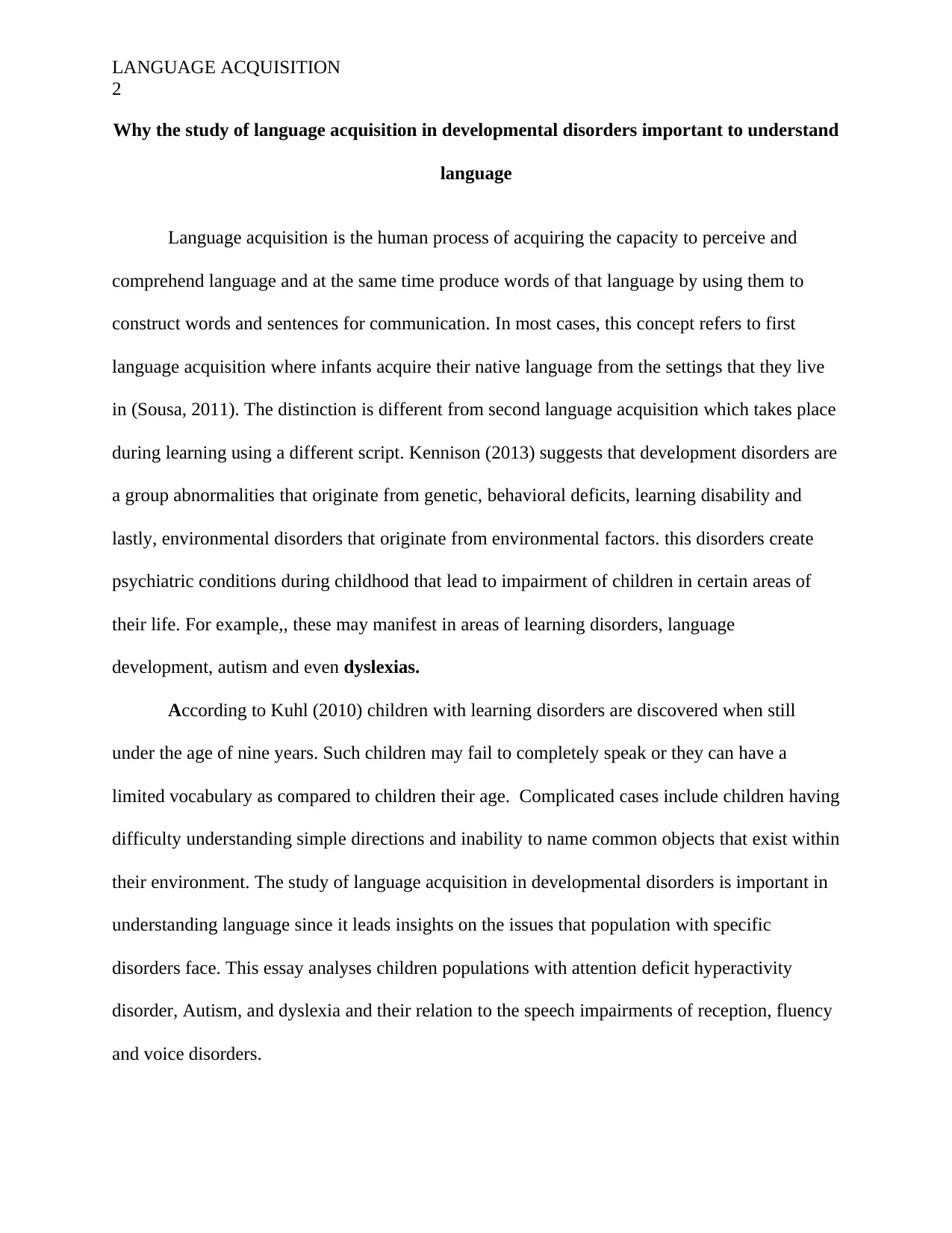
LANGUAGE ACQUISITION
2
Why the study of language acquisition in developmental disorders important to understand
language
Language acquisition is the human process of acquiring the capacity to perceive and
comprehend language and at the same time produce words of that language by using them to
construct words and sentences for communication. In most cases, this concept refers to first
language acquisition where infants acquire their native language from the settings that they live
in (Sousa, 2011). The distinction is different from second language acquisition which takes place
during learning using a different script. Kennison (2013) suggests that development disorders are
a group abnormalities that originate from genetic, behavioral deficits, learning disability and
lastly, environmental disorders that originate from environmental factors. this disorders create
psychiatric conditions during childhood that lead to impairment of children in certain areas of
their life. For example,, these may manifest in areas of learning disorders, language
development, autism and even dyslexias.
According to Kuhl (2010) children with learning disorders are discovered when still
under the age of nine years. Such children may fail to completely speak or they can have a
limited vocabulary as compared to children their age. Complicated cases include children having
difficulty understanding simple directions and inability to name common objects that exist within
their environment. The study of language acquisition in developmental disorders is important in
understanding language since it leads insights on the issues that population with specific
disorders face. This essay analyses children populations with attention deficit hyperactivity
disorder, Autism, and dyslexia and their relation to the speech impairments of reception, fluency
and voice disorders.
2
Why the study of language acquisition in developmental disorders important to understand
language
Language acquisition is the human process of acquiring the capacity to perceive and
comprehend language and at the same time produce words of that language by using them to
construct words and sentences for communication. In most cases, this concept refers to first
language acquisition where infants acquire their native language from the settings that they live
in (Sousa, 2011). The distinction is different from second language acquisition which takes place
during learning using a different script. Kennison (2013) suggests that development disorders are
a group abnormalities that originate from genetic, behavioral deficits, learning disability and
lastly, environmental disorders that originate from environmental factors. this disorders create
psychiatric conditions during childhood that lead to impairment of children in certain areas of
their life. For example,, these may manifest in areas of learning disorders, language
development, autism and even dyslexias.
According to Kuhl (2010) children with learning disorders are discovered when still
under the age of nine years. Such children may fail to completely speak or they can have a
limited vocabulary as compared to children their age. Complicated cases include children having
difficulty understanding simple directions and inability to name common objects that exist within
their environment. The study of language acquisition in developmental disorders is important in
understanding language since it leads insights on the issues that population with specific
disorders face. This essay analyses children populations with attention deficit hyperactivity
disorder, Autism, and dyslexia and their relation to the speech impairments of reception, fluency
and voice disorders.
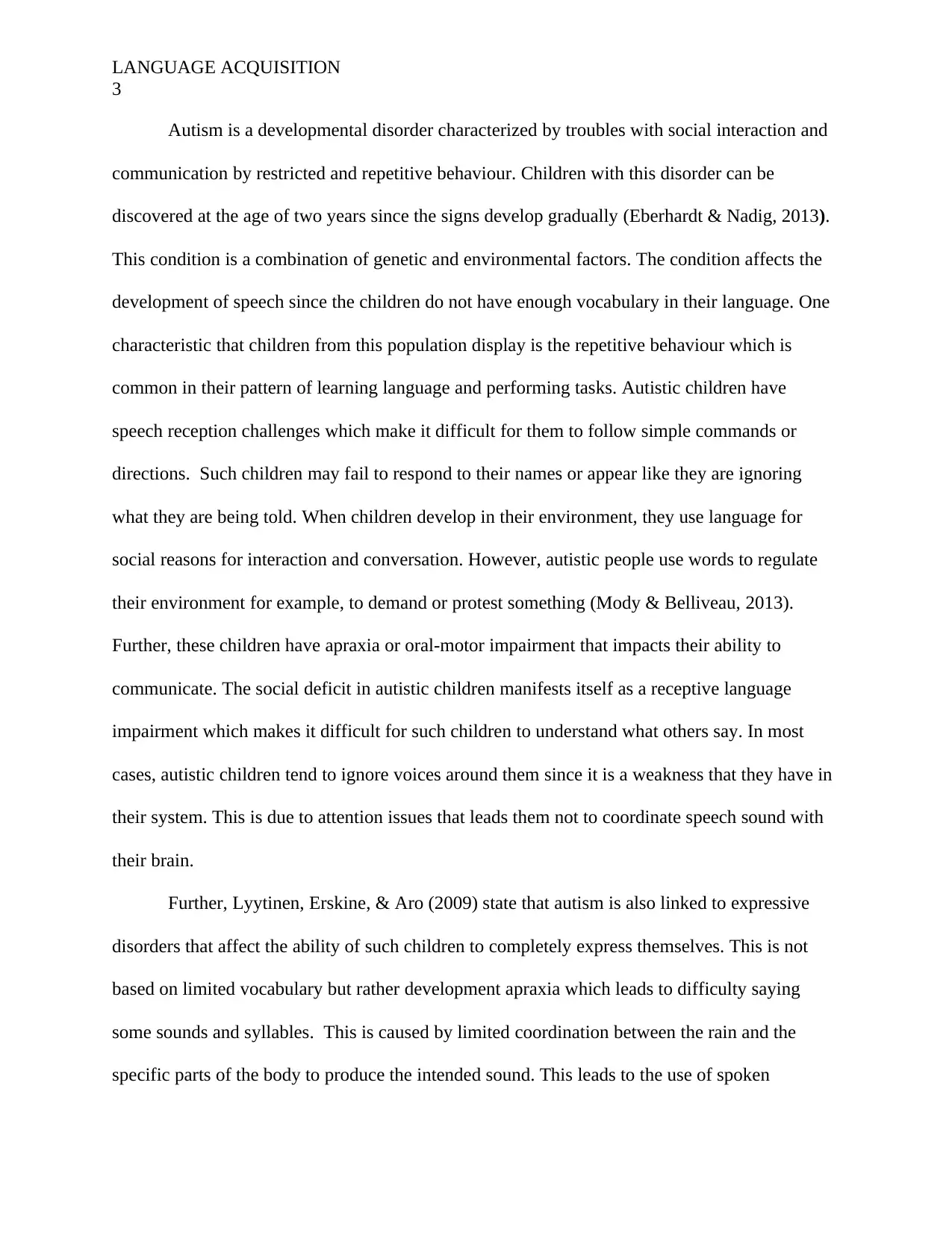
LANGUAGE ACQUISITION
3
Autism is a developmental disorder characterized by troubles with social interaction and
communication by restricted and repetitive behaviour. Children with this disorder can be
discovered at the age of two years since the signs develop gradually (Eberhardt & Nadig, 2013).
This condition is a combination of genetic and environmental factors. The condition affects the
development of speech since the children do not have enough vocabulary in their language. One
characteristic that children from this population display is the repetitive behaviour which is
common in their pattern of learning language and performing tasks. Autistic children have
speech reception challenges which make it difficult for them to follow simple commands or
directions. Such children may fail to respond to their names or appear like they are ignoring
what they are being told. When children develop in their environment, they use language for
social reasons for interaction and conversation. However, autistic people use words to regulate
their environment for example, to demand or protest something (Mody & Belliveau, 2013).
Further, these children have apraxia or oral-motor impairment that impacts their ability to
communicate. The social deficit in autistic children manifests itself as a receptive language
impairment which makes it difficult for such children to understand what others say. In most
cases, autistic children tend to ignore voices around them since it is a weakness that they have in
their system. This is due to attention issues that leads them not to coordinate speech sound with
their brain.
Further, Lyytinen, Erskine, & Aro (2009) state that autism is also linked to expressive
disorders that affect the ability of such children to completely express themselves. This is not
based on limited vocabulary but rather development apraxia which leads to difficulty saying
some sounds and syllables. This is caused by limited coordination between the rain and the
specific parts of the body to produce the intended sound. This leads to the use of spoken
3
Autism is a developmental disorder characterized by troubles with social interaction and
communication by restricted and repetitive behaviour. Children with this disorder can be
discovered at the age of two years since the signs develop gradually (Eberhardt & Nadig, 2013).
This condition is a combination of genetic and environmental factors. The condition affects the
development of speech since the children do not have enough vocabulary in their language. One
characteristic that children from this population display is the repetitive behaviour which is
common in their pattern of learning language and performing tasks. Autistic children have
speech reception challenges which make it difficult for them to follow simple commands or
directions. Such children may fail to respond to their names or appear like they are ignoring
what they are being told. When children develop in their environment, they use language for
social reasons for interaction and conversation. However, autistic people use words to regulate
their environment for example, to demand or protest something (Mody & Belliveau, 2013).
Further, these children have apraxia or oral-motor impairment that impacts their ability to
communicate. The social deficit in autistic children manifests itself as a receptive language
impairment which makes it difficult for such children to understand what others say. In most
cases, autistic children tend to ignore voices around them since it is a weakness that they have in
their system. This is due to attention issues that leads them not to coordinate speech sound with
their brain.
Further, Lyytinen, Erskine, & Aro (2009) state that autism is also linked to expressive
disorders that affect the ability of such children to completely express themselves. This is not
based on limited vocabulary but rather development apraxia which leads to difficulty saying
some sounds and syllables. This is caused by limited coordination between the rain and the
specific parts of the body to produce the intended sound. This leads to the use of spoken
⊘ This is a preview!⊘
Do you want full access?
Subscribe today to unlock all pages.

Trusted by 1+ million students worldwide
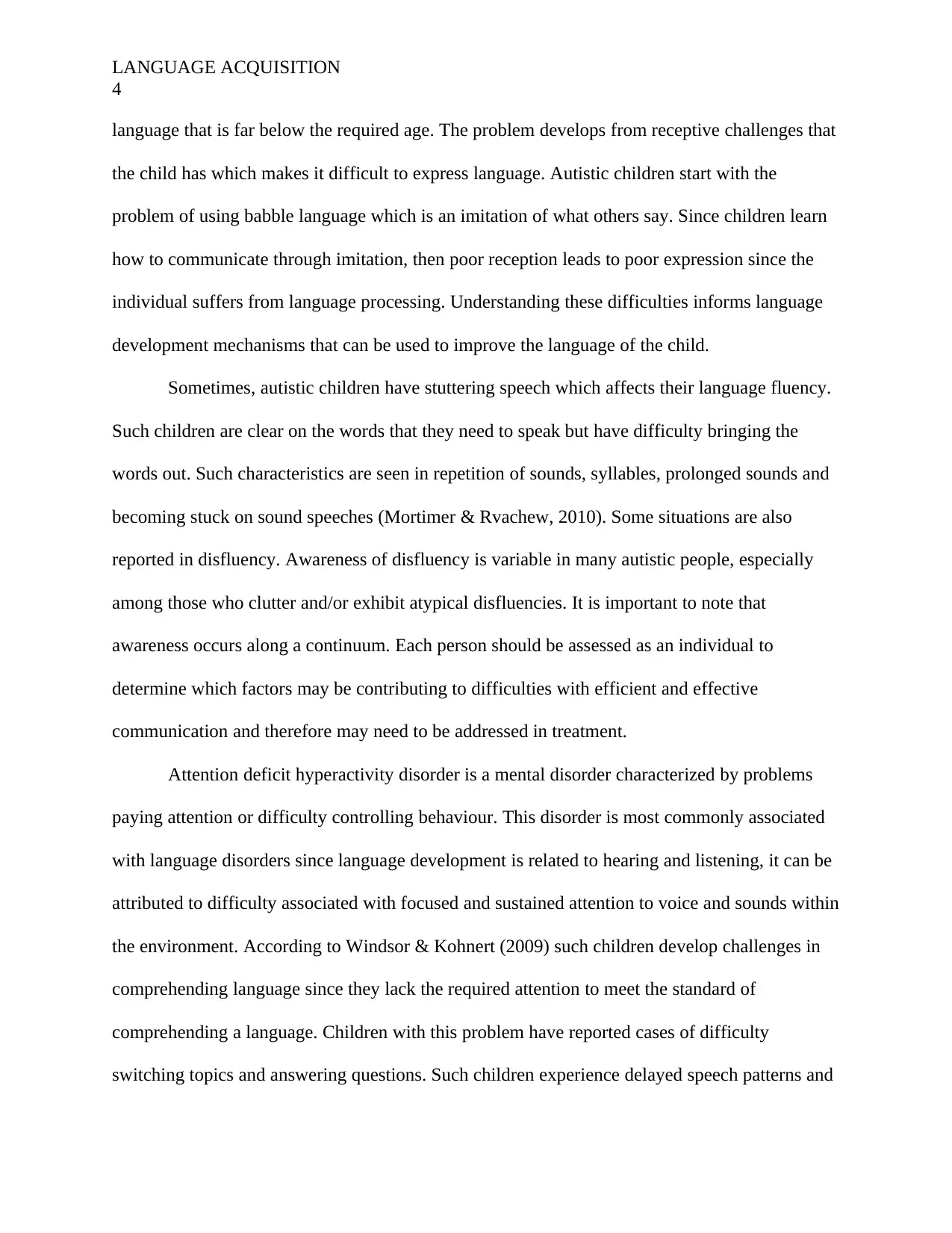
LANGUAGE ACQUISITION
4
language that is far below the required age. The problem develops from receptive challenges that
the child has which makes it difficult to express language. Autistic children start with the
problem of using babble language which is an imitation of what others say. Since children learn
how to communicate through imitation, then poor reception leads to poor expression since the
individual suffers from language processing. Understanding these difficulties informs language
development mechanisms that can be used to improve the language of the child.
Sometimes, autistic children have stuttering speech which affects their language fluency.
Such children are clear on the words that they need to speak but have difficulty bringing the
words out. Such characteristics are seen in repetition of sounds, syllables, prolonged sounds and
becoming stuck on sound speeches (Mortimer & Rvachew, 2010). Some situations are also
reported in disfluency. Awareness of disfluency is variable in many autistic people, especially
among those who clutter and/or exhibit atypical disfluencies. It is important to note that
awareness occurs along a continuum. Each person should be assessed as an individual to
determine which factors may be contributing to difficulties with efficient and effective
communication and therefore may need to be addressed in treatment.
Attention deficit hyperactivity disorder is a mental disorder characterized by problems
paying attention or difficulty controlling behaviour. This disorder is most commonly associated
with language disorders since language development is related to hearing and listening, it can be
attributed to difficulty associated with focused and sustained attention to voice and sounds within
the environment. According to Windsor & Kohnert (2009) such children develop challenges in
comprehending language since they lack the required attention to meet the standard of
comprehending a language. Children with this problem have reported cases of difficulty
switching topics and answering questions. Such children experience delayed speech patterns and
4
language that is far below the required age. The problem develops from receptive challenges that
the child has which makes it difficult to express language. Autistic children start with the
problem of using babble language which is an imitation of what others say. Since children learn
how to communicate through imitation, then poor reception leads to poor expression since the
individual suffers from language processing. Understanding these difficulties informs language
development mechanisms that can be used to improve the language of the child.
Sometimes, autistic children have stuttering speech which affects their language fluency.
Such children are clear on the words that they need to speak but have difficulty bringing the
words out. Such characteristics are seen in repetition of sounds, syllables, prolonged sounds and
becoming stuck on sound speeches (Mortimer & Rvachew, 2010). Some situations are also
reported in disfluency. Awareness of disfluency is variable in many autistic people, especially
among those who clutter and/or exhibit atypical disfluencies. It is important to note that
awareness occurs along a continuum. Each person should be assessed as an individual to
determine which factors may be contributing to difficulties with efficient and effective
communication and therefore may need to be addressed in treatment.
Attention deficit hyperactivity disorder is a mental disorder characterized by problems
paying attention or difficulty controlling behaviour. This disorder is most commonly associated
with language disorders since language development is related to hearing and listening, it can be
attributed to difficulty associated with focused and sustained attention to voice and sounds within
the environment. According to Windsor & Kohnert (2009) such children develop challenges in
comprehending language since they lack the required attention to meet the standard of
comprehending a language. Children with this problem have reported cases of difficulty
switching topics and answering questions. Such children experience delayed speech patterns and
Paraphrase This Document
Need a fresh take? Get an instant paraphrase of this document with our AI Paraphraser
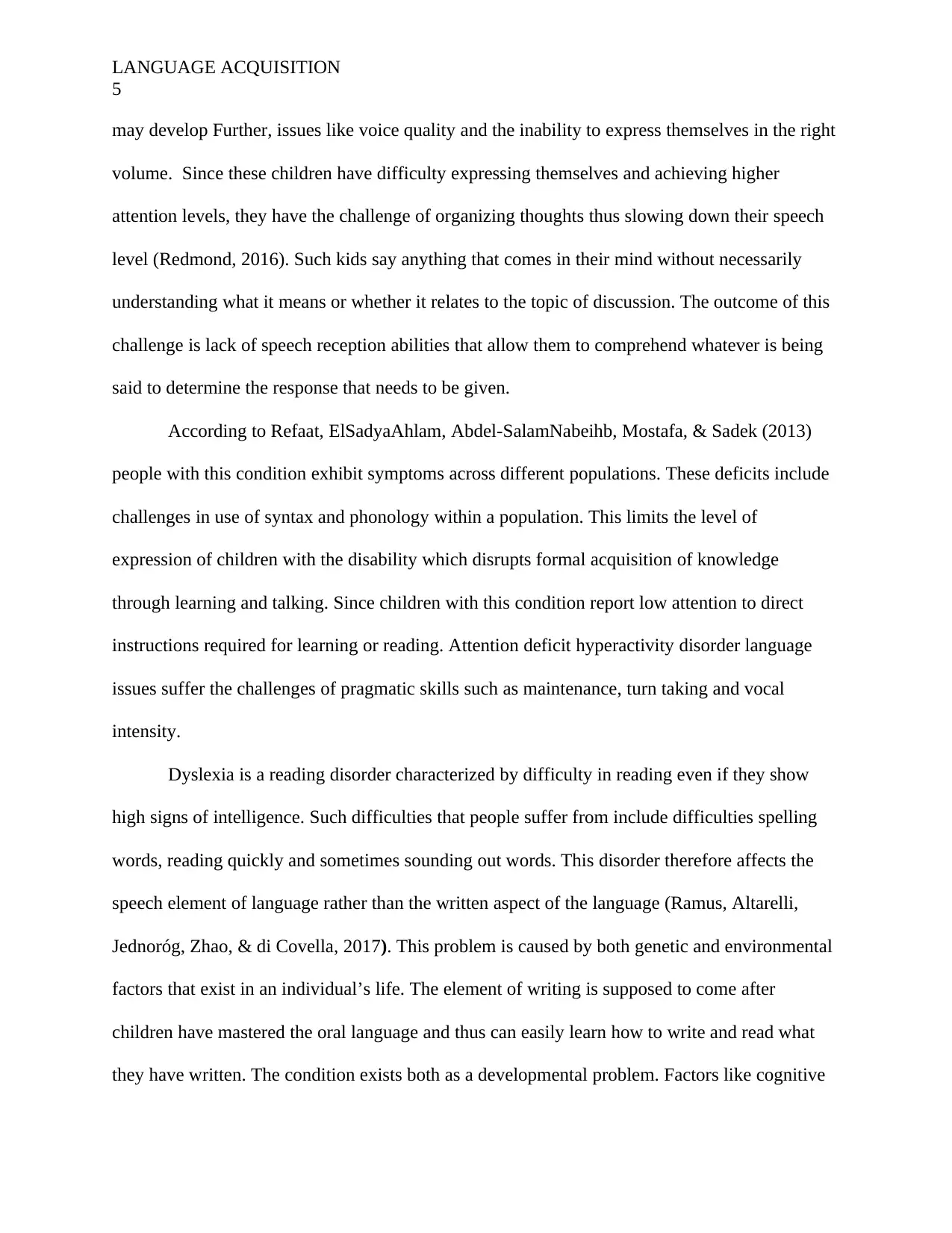
LANGUAGE ACQUISITION
5
may develop Further, issues like voice quality and the inability to express themselves in the right
volume. Since these children have difficulty expressing themselves and achieving higher
attention levels, they have the challenge of organizing thoughts thus slowing down their speech
level (Redmond, 2016). Such kids say anything that comes in their mind without necessarily
understanding what it means or whether it relates to the topic of discussion. The outcome of this
challenge is lack of speech reception abilities that allow them to comprehend whatever is being
said to determine the response that needs to be given.
According to Refaat, ElSadyaAhlam, Abdel-SalamNabeihb, Mostafa, & Sadek (2013)
people with this condition exhibit symptoms across different populations. These deficits include
challenges in use of syntax and phonology within a population. This limits the level of
expression of children with the disability which disrupts formal acquisition of knowledge
through learning and talking. Since children with this condition report low attention to direct
instructions required for learning or reading. Attention deficit hyperactivity disorder language
issues suffer the challenges of pragmatic skills such as maintenance, turn taking and vocal
intensity.
Dyslexia is a reading disorder characterized by difficulty in reading even if they show
high signs of intelligence. Such difficulties that people suffer from include difficulties spelling
words, reading quickly and sometimes sounding out words. This disorder therefore affects the
speech element of language rather than the written aspect of the language (Ramus, Altarelli,
Jednoróg, Zhao, & di Covella, 2017). This problem is caused by both genetic and environmental
factors that exist in an individual’s life. The element of writing is supposed to come after
children have mastered the oral language and thus can easily learn how to write and read what
they have written. The condition exists both as a developmental problem. Factors like cognitive
5
may develop Further, issues like voice quality and the inability to express themselves in the right
volume. Since these children have difficulty expressing themselves and achieving higher
attention levels, they have the challenge of organizing thoughts thus slowing down their speech
level (Redmond, 2016). Such kids say anything that comes in their mind without necessarily
understanding what it means or whether it relates to the topic of discussion. The outcome of this
challenge is lack of speech reception abilities that allow them to comprehend whatever is being
said to determine the response that needs to be given.
According to Refaat, ElSadyaAhlam, Abdel-SalamNabeihb, Mostafa, & Sadek (2013)
people with this condition exhibit symptoms across different populations. These deficits include
challenges in use of syntax and phonology within a population. This limits the level of
expression of children with the disability which disrupts formal acquisition of knowledge
through learning and talking. Since children with this condition report low attention to direct
instructions required for learning or reading. Attention deficit hyperactivity disorder language
issues suffer the challenges of pragmatic skills such as maintenance, turn taking and vocal
intensity.
Dyslexia is a reading disorder characterized by difficulty in reading even if they show
high signs of intelligence. Such difficulties that people suffer from include difficulties spelling
words, reading quickly and sometimes sounding out words. This disorder therefore affects the
speech element of language rather than the written aspect of the language (Ramus, Altarelli,
Jednoróg, Zhao, & di Covella, 2017). This problem is caused by both genetic and environmental
factors that exist in an individual’s life. The element of writing is supposed to come after
children have mastered the oral language and thus can easily learn how to write and read what
they have written. The condition exists both as a developmental problem. Factors like cognitive
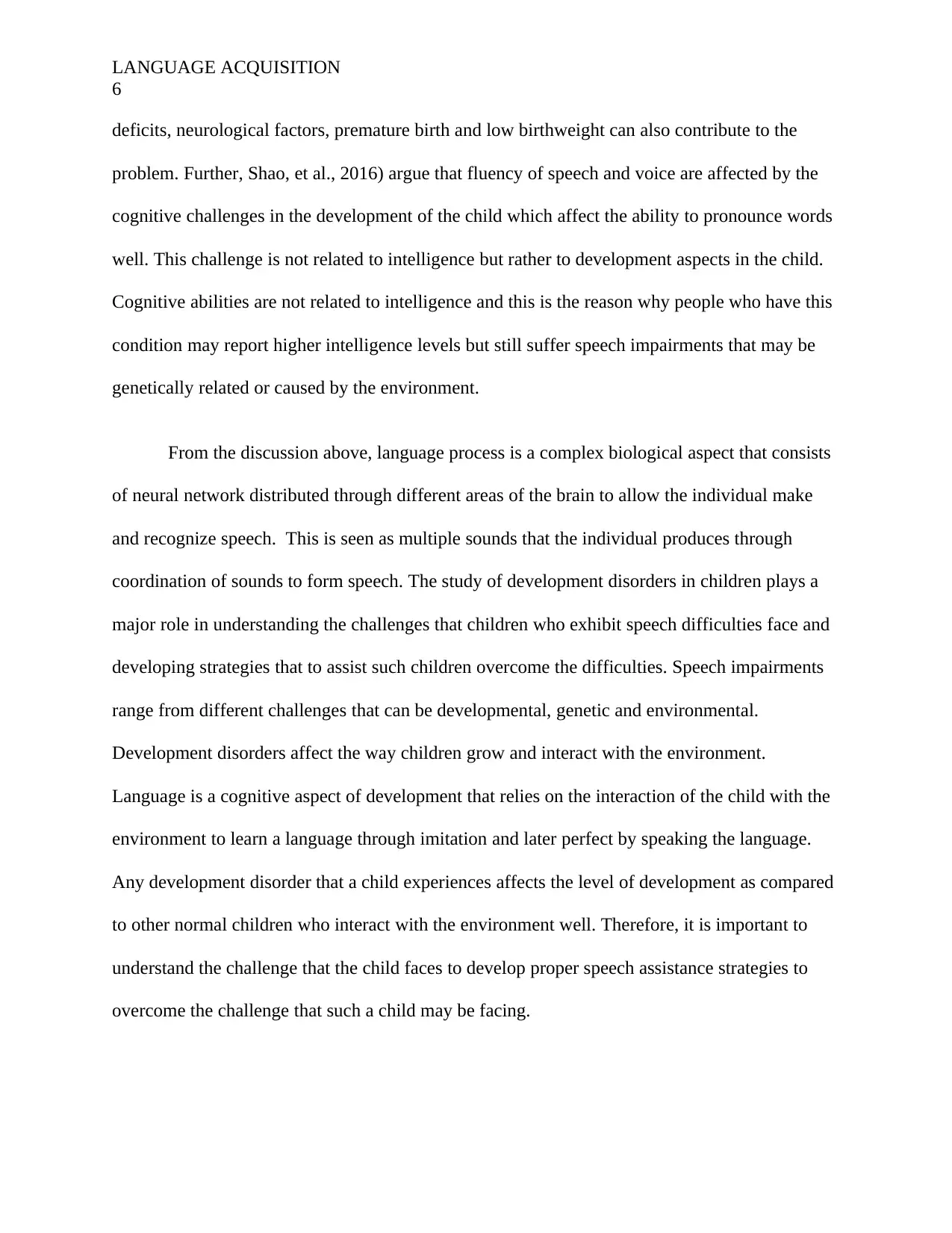
LANGUAGE ACQUISITION
6
deficits, neurological factors, premature birth and low birthweight can also contribute to the
problem. Further, Shao, et al., 2016) argue that fluency of speech and voice are affected by the
cognitive challenges in the development of the child which affect the ability to pronounce words
well. This challenge is not related to intelligence but rather to development aspects in the child.
Cognitive abilities are not related to intelligence and this is the reason why people who have this
condition may report higher intelligence levels but still suffer speech impairments that may be
genetically related or caused by the environment.
From the discussion above, language process is a complex biological aspect that consists
of neural network distributed through different areas of the brain to allow the individual make
and recognize speech. This is seen as multiple sounds that the individual produces through
coordination of sounds to form speech. The study of development disorders in children plays a
major role in understanding the challenges that children who exhibit speech difficulties face and
developing strategies that to assist such children overcome the difficulties. Speech impairments
range from different challenges that can be developmental, genetic and environmental.
Development disorders affect the way children grow and interact with the environment.
Language is a cognitive aspect of development that relies on the interaction of the child with the
environment to learn a language through imitation and later perfect by speaking the language.
Any development disorder that a child experiences affects the level of development as compared
to other normal children who interact with the environment well. Therefore, it is important to
understand the challenge that the child faces to develop proper speech assistance strategies to
overcome the challenge that such a child may be facing.
6
deficits, neurological factors, premature birth and low birthweight can also contribute to the
problem. Further, Shao, et al., 2016) argue that fluency of speech and voice are affected by the
cognitive challenges in the development of the child which affect the ability to pronounce words
well. This challenge is not related to intelligence but rather to development aspects in the child.
Cognitive abilities are not related to intelligence and this is the reason why people who have this
condition may report higher intelligence levels but still suffer speech impairments that may be
genetically related or caused by the environment.
From the discussion above, language process is a complex biological aspect that consists
of neural network distributed through different areas of the brain to allow the individual make
and recognize speech. This is seen as multiple sounds that the individual produces through
coordination of sounds to form speech. The study of development disorders in children plays a
major role in understanding the challenges that children who exhibit speech difficulties face and
developing strategies that to assist such children overcome the difficulties. Speech impairments
range from different challenges that can be developmental, genetic and environmental.
Development disorders affect the way children grow and interact with the environment.
Language is a cognitive aspect of development that relies on the interaction of the child with the
environment to learn a language through imitation and later perfect by speaking the language.
Any development disorder that a child experiences affects the level of development as compared
to other normal children who interact with the environment well. Therefore, it is important to
understand the challenge that the child faces to develop proper speech assistance strategies to
overcome the challenge that such a child may be facing.
⊘ This is a preview!⊘
Do you want full access?
Subscribe today to unlock all pages.

Trusted by 1+ million students worldwide
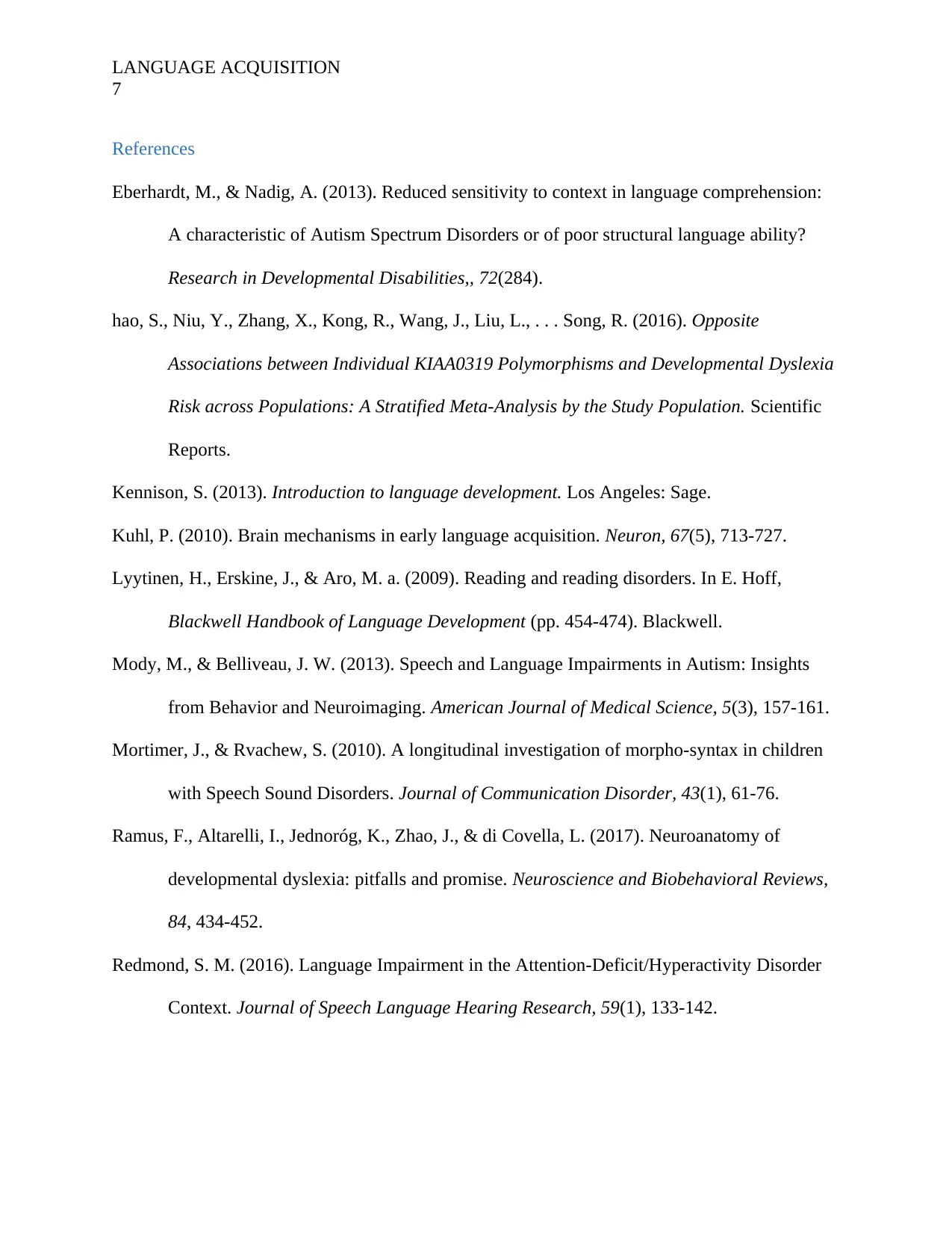
LANGUAGE ACQUISITION
7
References
Eberhardt, M., & Nadig, A. (2013). Reduced sensitivity to context in language comprehension:
A characteristic of Autism Spectrum Disorders or of poor structural language ability?
Research in Developmental Disabilities,, 72(284).
hao, S., Niu, Y., Zhang, X., Kong, R., Wang, J., Liu, L., . . . Song, R. (2016). Opposite
Associations between Individual KIAA0319 Polymorphisms and Developmental Dyslexia
Risk across Populations: A Stratified Meta-Analysis by the Study Population. Scientific
Reports.
Kennison, S. (2013). Introduction to language development. Los Angeles: Sage.
Kuhl, P. (2010). Brain mechanisms in early language acquisition. Neuron, 67(5), 713-727.
Lyytinen, H., Erskine, J., & Aro, M. a. (2009). Reading and reading disorders. In E. Hoff,
Blackwell Handbook of Language Development (pp. 454-474). Blackwell.
Mody, M., & Belliveau, J. W. (2013). Speech and Language Impairments in Autism: Insights
from Behavior and Neuroimaging. American Journal of Medical Science, 5(3), 157-161.
Mortimer, J., & Rvachew, S. (2010). A longitudinal investigation of morpho-syntax in children
with Speech Sound Disorders. Journal of Communication Disorder, 43(1), 61-76.
Ramus, F., Altarelli, I., Jednoróg, K., Zhao, J., & di Covella, L. (2017). Neuroanatomy of
developmental dyslexia: pitfalls and promise. Neuroscience and Biobehavioral Reviews,
84, 434-452.
Redmond, S. M. (2016). Language Impairment in the Attention-Deficit/Hyperactivity Disorder
Context. Journal of Speech Language Hearing Research, 59(1), 133-142.
7
References
Eberhardt, M., & Nadig, A. (2013). Reduced sensitivity to context in language comprehension:
A characteristic of Autism Spectrum Disorders or of poor structural language ability?
Research in Developmental Disabilities,, 72(284).
hao, S., Niu, Y., Zhang, X., Kong, R., Wang, J., Liu, L., . . . Song, R. (2016). Opposite
Associations between Individual KIAA0319 Polymorphisms and Developmental Dyslexia
Risk across Populations: A Stratified Meta-Analysis by the Study Population. Scientific
Reports.
Kennison, S. (2013). Introduction to language development. Los Angeles: Sage.
Kuhl, P. (2010). Brain mechanisms in early language acquisition. Neuron, 67(5), 713-727.
Lyytinen, H., Erskine, J., & Aro, M. a. (2009). Reading and reading disorders. In E. Hoff,
Blackwell Handbook of Language Development (pp. 454-474). Blackwell.
Mody, M., & Belliveau, J. W. (2013). Speech and Language Impairments in Autism: Insights
from Behavior and Neuroimaging. American Journal of Medical Science, 5(3), 157-161.
Mortimer, J., & Rvachew, S. (2010). A longitudinal investigation of morpho-syntax in children
with Speech Sound Disorders. Journal of Communication Disorder, 43(1), 61-76.
Ramus, F., Altarelli, I., Jednoróg, K., Zhao, J., & di Covella, L. (2017). Neuroanatomy of
developmental dyslexia: pitfalls and promise. Neuroscience and Biobehavioral Reviews,
84, 434-452.
Redmond, S. M. (2016). Language Impairment in the Attention-Deficit/Hyperactivity Disorder
Context. Journal of Speech Language Hearing Research, 59(1), 133-142.
Paraphrase This Document
Need a fresh take? Get an instant paraphrase of this document with our AI Paraphraser
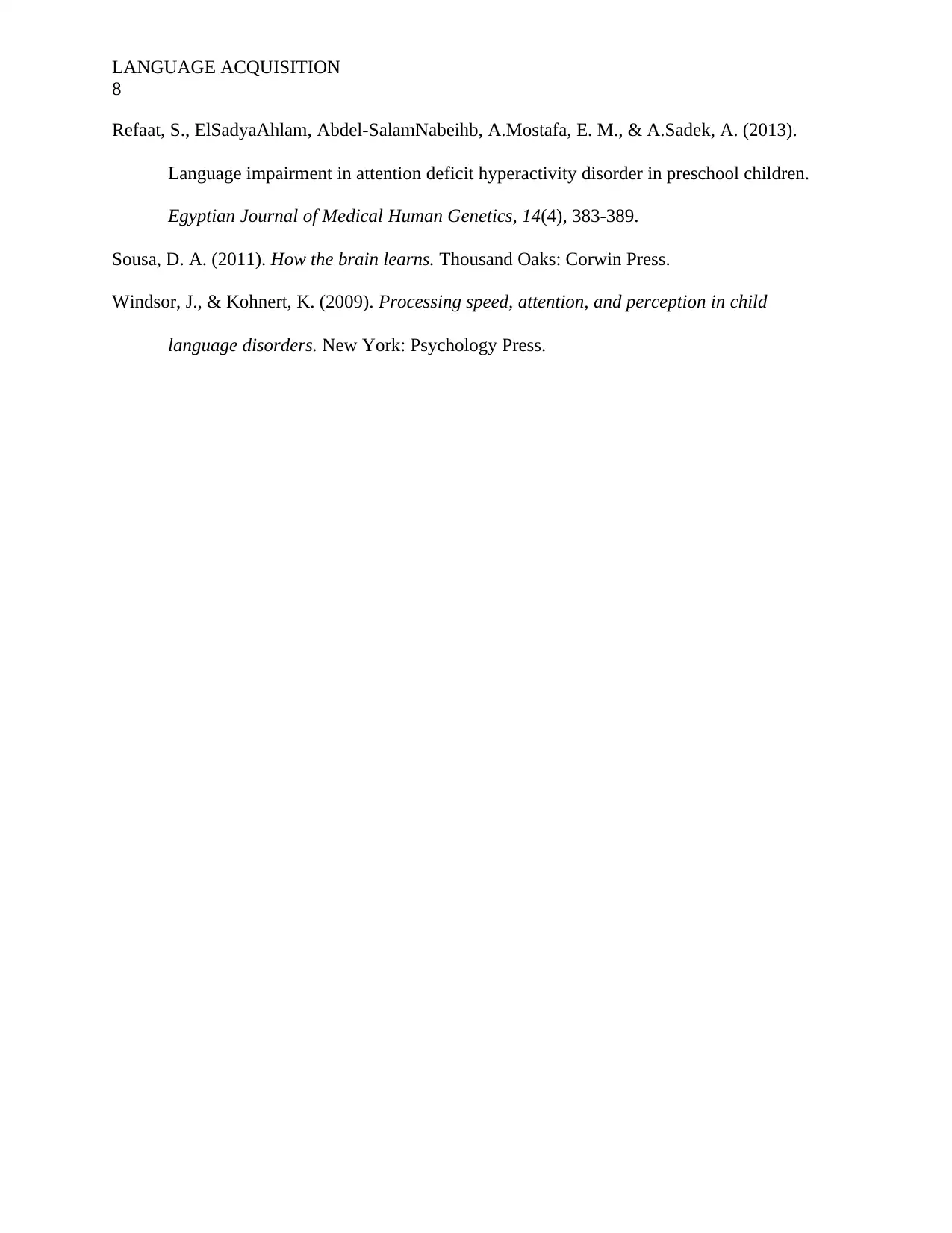
LANGUAGE ACQUISITION
8
Refaat, S., ElSadyaAhlam, Abdel-SalamNabeihb, A.Mostafa, E. M., & A.Sadek, A. (2013).
Language impairment in attention deficit hyperactivity disorder in preschool children.
Egyptian Journal of Medical Human Genetics, 14(4), 383-389.
Sousa, D. A. (2011). How the brain learns. Thousand Oaks: Corwin Press.
Windsor, J., & Kohnert, K. (2009). Processing speed, attention, and perception in child
language disorders. New York: Psychology Press.
8
Refaat, S., ElSadyaAhlam, Abdel-SalamNabeihb, A.Mostafa, E. M., & A.Sadek, A. (2013).
Language impairment in attention deficit hyperactivity disorder in preschool children.
Egyptian Journal of Medical Human Genetics, 14(4), 383-389.
Sousa, D. A. (2011). How the brain learns. Thousand Oaks: Corwin Press.
Windsor, J., & Kohnert, K. (2009). Processing speed, attention, and perception in child
language disorders. New York: Psychology Press.
1 out of 8
Related Documents
Your All-in-One AI-Powered Toolkit for Academic Success.
+13062052269
info@desklib.com
Available 24*7 on WhatsApp / Email
![[object Object]](/_next/static/media/star-bottom.7253800d.svg)
Unlock your academic potential
Copyright © 2020–2025 A2Z Services. All Rights Reserved. Developed and managed by ZUCOL.





